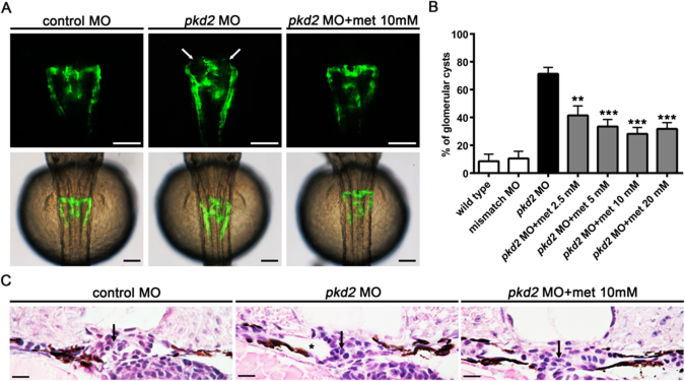Our official English website, www.x-mol.net, welcomes your
feedback! (Note: you will need to create a separate account there.)
Metformin Inhibits Cyst Formation in a Zebrafish Model of Polycystin-2 Deficiency.
Scientific Reports ( IF 3.8 ) Pub Date : 2017-Aug-02 , DOI: 10.1038/s41598-017-07300-x
Ming-Yang Chang , Tsu-Lin Ma , Cheng-Chieh Hung , Ya-Chung Tian , Yung-Chang Chen , Chih-Wei Yang , Yi-Chuan Cheng
Scientific Reports ( IF 3.8 ) Pub Date : 2017-Aug-02 , DOI: 10.1038/s41598-017-07300-x
Ming-Yang Chang , Tsu-Lin Ma , Cheng-Chieh Hung , Ya-Chung Tian , Yung-Chang Chen , Chih-Wei Yang , Yi-Chuan Cheng

|
Autosomal dominant polycystic kidney disease (ADPKD) is a common kidney disease caused by mutations in PKD1 or PKD2. Metformin reduces cyst growth in mouse models of PKD1. However, metformin has not been studied in animal models of PKD2, and the cellular mechanism underlying its effectiveness is not entirely clear. This study investigated the effects of metformin on cyst formation in a zebrafish model of polycystin-2 deficiency resulting from morpholino knockdown of pkd2. We added metformin (2.5 to 20 mM) to the embryo media between 4 and 48 hours post fertilisation and observed pronephric cyst formation by using the wt1b promoter-driven GFP signal in Tg(wt1b:GFP) pkd2 morphants. Metformin inhibited pronephric cyst formation by 42-61% compared with the untreated controls. Metformin also reduced the number of proliferating cells in the pronephric ducts, the degree of dorsal body curvature, and the infiltration of leukocytes surrounding the pronephros. Moreover, metformin treatment increased the phosphorylation of adenosine monophosphate-activated protein kinase (AMPK) and enhanced autophagy in the pronephros. Our data suggest that metformin reduces cyst formation through activation of the AMPK pathway and modulation of defective cellular events such as proliferation and autophagy. These results also imply that metformin could have therapeutic potential for ADPKD treatment.
中文翻译:

二甲双胍可抑制多囊藻-2缺乏症的斑马鱼模型中的囊肿形成。
常染色体显性遗传性多囊肾(ADPKD)是由PKD1或PKD2突变引起的常见肾脏疾病。二甲双胍可降低PKD1小鼠模型中的囊肿生长。但是,尚未在动物模型的PKD2中研究二甲双胍,其功效的细胞机制尚不完全清楚。这项研究调查了二甲双胍对斑马鱼模型中多囊藻-2缺失(由pkd2的吗啉代敲除)引起的囊肿形成的影响。我们在受精后4至48小时之间将二甲双胍(2.5至20 mM)添加到胚胎培养基中,并在Tg(wt1b:GFP)pkd2 morphant中使用wt1b启动子驱动的GFP信号观察到肾前囊肿的形成。与未治疗的对照组相比,二甲双胍抑制前肾囊肿的形成42-61%。二甲双胍还减少了前肾管道中增殖细胞的数量,背侧身体弯曲的程度以及前肾周围白细胞的浸润。此外,二甲双胍治疗增加了前磷酸腺苷单磷酸腺苷激活的蛋白激酶(AMPK)的磷酸化,并增强了其自噬。我们的数据表明,二甲双胍通过激活AMPK途径和调节有缺陷的细胞事件(如增殖和自噬)来减少囊肿形成。这些结果还暗示二甲双胍可能具有ADPKD治疗的治疗潜力。二甲双胍治疗增加了单磷酸腺苷激活的蛋白激酶(AMPK)的磷酸化并增强了前肾中的自噬。我们的数据表明,二甲双胍通过激活AMPK途径和调节有缺陷的细胞事件(如增殖和自噬)来减少囊肿形成。这些结果还暗示二甲双胍可能具有ADPKD治疗的治疗潜力。二甲双胍治疗增加了单磷酸腺苷激活的蛋白激酶(AMPK)的磷酸化并增强了前肾中的自噬。我们的数据表明,二甲双胍通过激活AMPK途径和调节有缺陷的细胞事件(如增殖和自噬)来减少囊肿形成。这些结果还暗示二甲双胍可能具有ADPKD治疗的治疗潜力。
更新日期:2017-08-02
中文翻译:

二甲双胍可抑制多囊藻-2缺乏症的斑马鱼模型中的囊肿形成。
常染色体显性遗传性多囊肾(ADPKD)是由PKD1或PKD2突变引起的常见肾脏疾病。二甲双胍可降低PKD1小鼠模型中的囊肿生长。但是,尚未在动物模型的PKD2中研究二甲双胍,其功效的细胞机制尚不完全清楚。这项研究调查了二甲双胍对斑马鱼模型中多囊藻-2缺失(由pkd2的吗啉代敲除)引起的囊肿形成的影响。我们在受精后4至48小时之间将二甲双胍(2.5至20 mM)添加到胚胎培养基中,并在Tg(wt1b:GFP)pkd2 morphant中使用wt1b启动子驱动的GFP信号观察到肾前囊肿的形成。与未治疗的对照组相比,二甲双胍抑制前肾囊肿的形成42-61%。二甲双胍还减少了前肾管道中增殖细胞的数量,背侧身体弯曲的程度以及前肾周围白细胞的浸润。此外,二甲双胍治疗增加了前磷酸腺苷单磷酸腺苷激活的蛋白激酶(AMPK)的磷酸化,并增强了其自噬。我们的数据表明,二甲双胍通过激活AMPK途径和调节有缺陷的细胞事件(如增殖和自噬)来减少囊肿形成。这些结果还暗示二甲双胍可能具有ADPKD治疗的治疗潜力。二甲双胍治疗增加了单磷酸腺苷激活的蛋白激酶(AMPK)的磷酸化并增强了前肾中的自噬。我们的数据表明,二甲双胍通过激活AMPK途径和调节有缺陷的细胞事件(如增殖和自噬)来减少囊肿形成。这些结果还暗示二甲双胍可能具有ADPKD治疗的治疗潜力。二甲双胍治疗增加了单磷酸腺苷激活的蛋白激酶(AMPK)的磷酸化并增强了前肾中的自噬。我们的数据表明,二甲双胍通过激活AMPK途径和调节有缺陷的细胞事件(如增殖和自噬)来减少囊肿形成。这些结果还暗示二甲双胍可能具有ADPKD治疗的治疗潜力。































 京公网安备 11010802027423号
京公网安备 11010802027423号